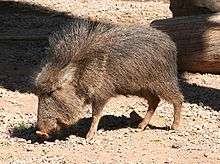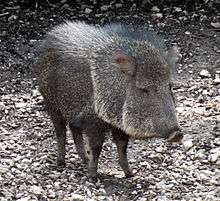Chacoan peccary
| Chacoan peccary | |
|---|---|
 | |
| At the Phoenix Zoo | |
| Scientific classification | |
| Kingdom: | Animalia |
| Phylum: | Chordata |
| Class: | Mammalia |
| Order: | Artiodactyla |
| Family: | Tayassuidae |
| Genus: | Catagonus Ameghino, 1904 |
| Binomial name | |
| Catagonus wagneri (Rusconi, 1930) | |
| | |
| Synonyms | |
|
Parachoerus wagneri Rusconi, 1930 | |
The Chacoan peccary or tagua (Catagonus wagneri) is the last extant species of the genus Catagonus;[2] it is a peccary found in the Gran Chaco of Paraguay, Bolivia, and Argentina. About 3000 exist in the world. It is believed to be the closest living relative to the extinct genus Platygonus.
The Chacoan peccary has the unusual distinction of having been first described in 1930 based on fossils and was originally thought to be an extinct species. In 1971, the animal was discovered to still be alive in the Chaco region, in the Argentine province of Salta. The species was well known to the native people, but it took a while for scientists to acknowledge its existence. It is known locally as the tagua.
Habitat
The Chacoan peccary is confined to hot, dry areas. Dominated by low-lying succulents and thorny bushes, the Gran Chaco is about 140,000 km2. A few scattered giant trees are found, but the majority of the vegetation is thorny scrub vegetation. The Chacoan peccary has developed adaptations such as well-developed sinuses to combat dry, dusty conditions. Their feet are also small, which allows maneuverability among spiny plants.
Physical characteristics
The largest of the three generally accepted species of peccaries, the Chacoan peccary has many pig-like features. It is an ungulate with a well-formed rostrum with a tough leathery snout. The bristle-like hair is generally brown to almost gray. A dark stripe runs across the back, and white fur is on the shoulders. Chacoan peccaries differ from other peccary species by having longer ears, snouts, and tails. It has white hairs around the mouth, unlike other peccaries. Catagonus wagneri also has a third hind toe, but other peccaries only have two. The hypsodont teeth follow this dental formula: 2/3, 1/1, 3/3, 3/3 . The upper canines display the distinguishing trait of peccaries, pointing downwards instead of out and up like other Suiformes. When the Chacoan peccary is nervous or frightened, it flees, and raises the hairs on its back. While escaping, it sprays secretions from its dorsal glands, which may be a signal for other peccaries to keep the group together through the dense bush.[3]
Reproduction
Young are generally born between September and December, but litters have been found almost year-round. Births have been linked to periods of food abundance and rainfall. The average number of embryos has been recorded as approximately 2.72. Females may leave the herd to give birth and then return afterwards. Newborns are precocial, able to run a few hours after birth. The pelage of the young resembles that of the adults. There is no sexual dimorphism.
Behavior
Chacoan peccaries often travel in herds of up to 20 individuals. They are active during the day, especially in the morning when they are most apt to travel. Herds display a general travel cycle within their home range of 42 days. This allows the individuals to monitor and show ownership over their areas.
These social mammals communicate by various sounds, ranging from grunts to chatters of the teeth. Though individuals may occasionally exhibit aggressive behavior such as charging and biting, this species is not as aggressive as others.
As a defensive strategy, members of a herd may line up in a defensive wall; this makes the herds easy targets for hunters. The Chacoan peccary produces a milky, odorous substance used for marking trees, shrubs, and similar. The substance is secreted from glands located on their backs, and is dispersed by rubbing. Frequently bathing in mud or dust, Chacoan peccaries also defecate at particular "stations".

Food habits
The arid habitat of the Gran Chaco region provides very tough vegetation for the Chacoan peccary. These peccaries feed on various species of cacti, such as Cleistocactus baumannii and Opuntia discolor. It uses its tough snout to roll the cacti on the ground, rubbing the spines off. It may pull off the spines with its teeth and spit them out. The kidneys are specialized to break down acids from the cacti. The two-chambered stomachs are also well suited to digest tough foods. Occasionally grazing on bromeliad roots, it also eats acacia pods and fallen cactus flowers. This species of peccary seeks out salt licks formed from ant mounds and construction projects (road building and land clearings). The Chacoan peccary gains essential minerals like calcium, magnesium, and chlorine from the salt licks.
Conservation status
Because the Chacoan peccary is endemic to a formerly isolated region of South America, it is most vulnerable to human activity. Just as quickly as this species is discovered in an area, it disappears. Herd numbers are decreasing as a result of habitat loss and fragmentation. Their range is being quickly transformed into large Texas-style ranches. Hunting also continues, as well as an unidentified disease that has plagued the herds in recent years. A population has been established in North American and European zoos. Preserves have also been established in Paraguay, but are not highly enforced.
References
- ↑ Altrichter, M.; Taber, A.; Noss, A.; Maffei, L. (2008). "Catagonus wagneri". IUCN Red List of Threatened Species. Version 2011.2. International Union for Conservation of Nature. Archived from the original on 22 November 1911.
- ↑ "Fossilworks: Catagonus". fossilworks.org. Retrieved 2016-05-01.
- ↑ Catagonus wagneri - Chacoan peccary Archived January 10, 2011, at the Wayback Machine.
| Wikispecies has information related to: Catagonus |
| Wikimedia Commons has media related to Catagonus wagneri. |
- Mayer, J. J.; Wetzel, R. M. (1986). "Catagonus wagneri". Mammalian Species. 259: 1–5. doi:10.2307/3503829.
- Wetzel, R. M. (1977a). "The extinction of peccaries and a new case of survival". Annals of the New York Academy of Sciences. 288: 538–544. doi:10.1111/j.1749-6632.1977.tb33641.x.
- Wetzel, R. M. (1977b). "The Chacoan peccary, Catagonus wagneri (Rusconi)". Bulletin of the Carnegie Museum of Natural History. 3: 1–36.
- Wetzel, R. M.; Dubos, R. E.; Martin, R. L.; Myers, P. (1975). "Catagonus, an 'extinct' peccary alive in Paraguay". Science. 189 (4200): 379–381. doi:10.1126/science.189.4200.379. PMID 17840828.
